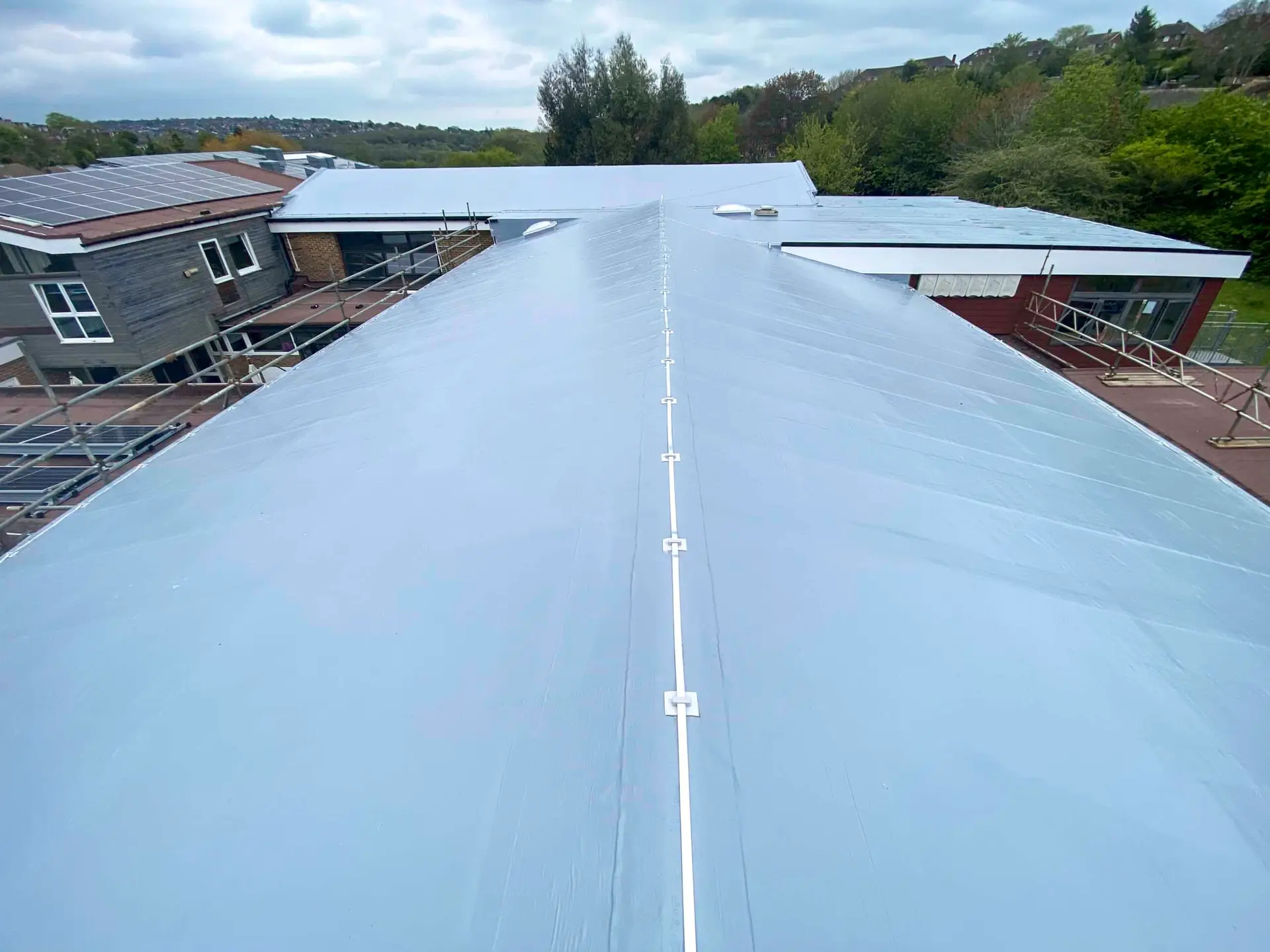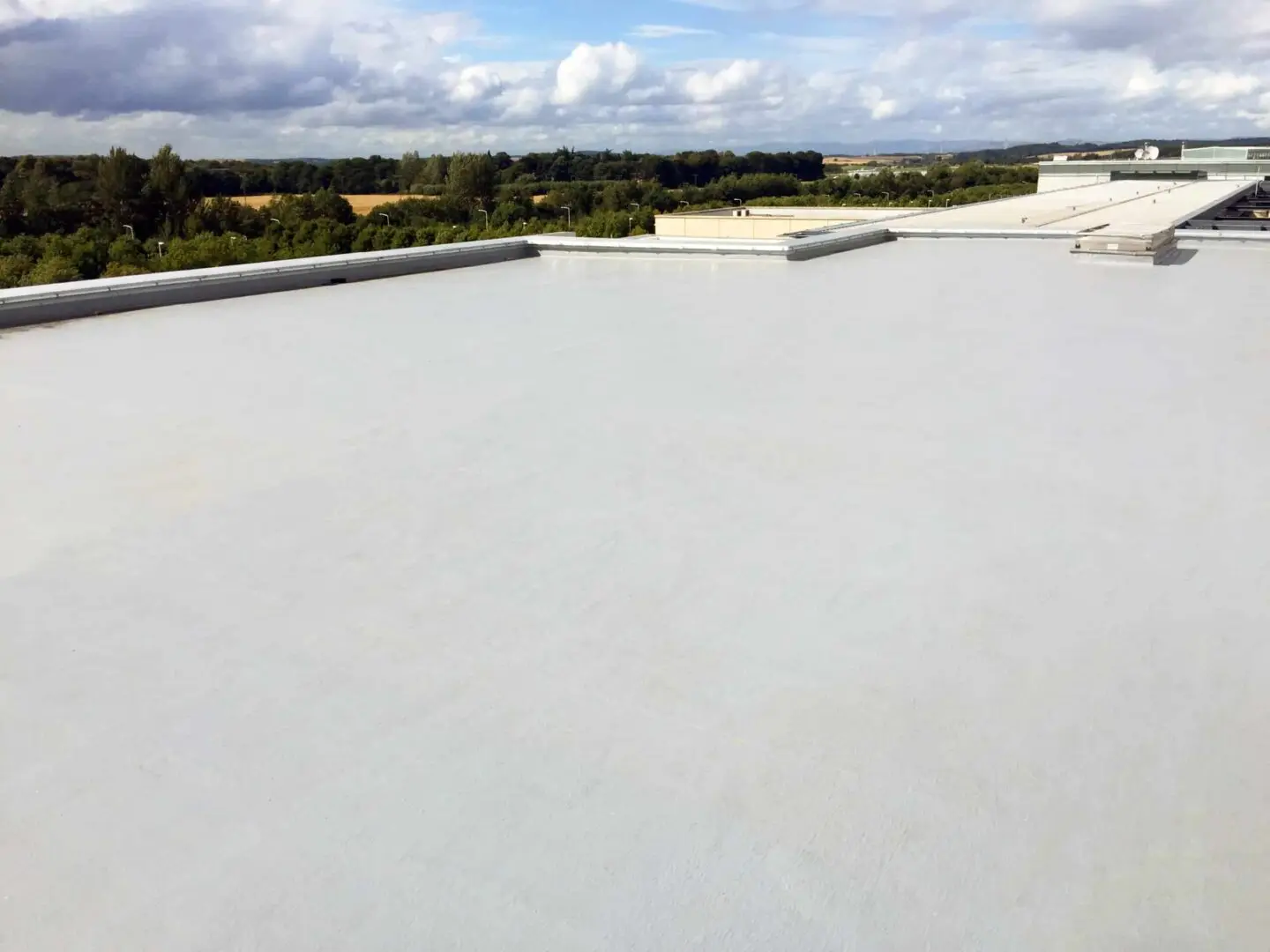

As the name suggests, liquid waterproofing is any waterproofing system that can be applied in a liquid form to provide a waterproof barrier to restore an existing roofing membrane or act as a new waterproofing system. These systems can be applied to a roofing substrate while still in liquid form; they then cure to form a synthetic monolithic membrane which is both strong and flexible. If extra support is needed, they can be reinforced with fibreglass or polyester reinforcements.
There are a number of different liquid waterproofing technologies available, usually based on the following compounds; acrylic copolymers, bitumen, polyurethanes, methyl methacrylate and silicone resins.
Advantages and Disadvantages of Polyurethane Technology
Garland UK currently use polyurethane and methyl methacrylate-based liquid waterproofing systems. We believe these offer the most superior liquid waterproofing technology available due to their significant advantages and limited disadvantages.
Polyurethane Advantages:
- Durability: Polyurethane roofing is highly resistant to extreme temperature variations and UV exposure. It can be formulated to be extremely resistant to chemicals making it a long-lasting roofing solution.
- Versatility: Polyurethane roofing can be applied to a wide range of roofing surfaces, including bitumen, concrete, metals and wood. It also makes waterproofing complex detailing easy.
- Comfort and Odour: Solvent-free and odourless variations are possible, ensuring building occupants are not disrupted, and installers are more comfortable during installation.
- Elasticity: Polyurethane roofing has excellent elasticity, providing excellent crack-bridging properties that can accommodate the usual expansion and contraction that buildings experience.
- Waterproofing: Polyurethane roofing provides an excellent waterproof barrier that will prevent water damage to the underlying structure.
Polyurethane Disadvantages:
- Installation: Whilst it is simple to install, a well-trained installer must be used to get a good aesthetic finish and ensure roof details are completed correctly.
- Climate: Polyurethanes are particularly sensitive to moisture and temperature. Therefore, they should not be used when temperatures are extreme or humid.
- Compatibility: Whilst polyurethanes have good compatibility with most substrates and existing coatings, they can not be applied over existing silicone-based coatings.

Polyurethane Modified Methyl Methacrylate (MMA) Advantages:
It has all the same advantages as Polyurethane but with some added benefits:
- Durability: Polyurethane Modified MMA is even more durable than Polyurethane and can act as a root barrier for green roof systems and used as a pedestrian or vehicular coating system
- Extremely fast cure time: Polyurethane Modified MMA cure within 30-60 minutes and is rain resistant within 20 minutes in normal conditions; this can be even faster in warmer weather.
- Adhesion: MMA is particularly good at bonding to a variety of materials and can therefore be better suited to multiple substrates on a roofing project.
Polyurethane Modified Methyl Methacrylate (MMA) Disadvantages:
- Odour: MMA has a very pungent and unique smell and can therefore be easily noticed by building occupants and can cause issues with installers if not used in well-ventilated areas.
- Installation: The extremely fast cure time and addition of catalysts necessitate highly trained installers.
As you can see, a huge variety of different roofing needs can be easily accommodated between standard Polyurethane based systems and Polyurethane Modified MMA systems.

Application benefits
Liquid waterproofing is an exceptionally versatile roofing solution. With the advantages we have already covered, it is a popular waterproofing solution for many applications, including low-slope flat roofs, balconies, walkways and even car parks.
Liquid waterproofing can be applied over a large variety of substrates or existing roofing systems, including:
- Mastic Asphalt
- Bituminous membranes,
- Single Ply Membranes (PVC)
- Metal Roofing
- Cement-based roof sheeting coating and encapsulation.
- Concrete/Screeds
This ability to be applied to many existing roofing systems makes liquid waterproofing especially suitable for new builds and refurbishment projects.
For roof refurbishments, it allows for repairing failures in existing waterproofing whilst enhancing its aesthetic appearance and restoring the roof, extending its life and reducing carbon emissions. White-coloured variations can also be incorporated to improve the energy efficiency of existing roofs by reflecting solar radiation and maintaining a stable, cooler temperature inside the building.
Liquid waterproofing creates a seamless, continuous barrier that is highly resistant to water, UV rays, and other external elements. This allows extremely complex details to be easily waterproofed and makes it an attractive option for commercial projects that accommodate significant plant equipment on their roof space.

Treatments
Asbestos encapsulation
liquid waterproofing can even be used to cover asbestos roofing in situ. The liquid waterproofing fully covers and seals the existing asbestos sheets eliminating the risks of airborne asbestos fibres.
These innovative solutions provide a fast, safe and far cheaper alternative to costly asbestos removal and mitigate significant waste to landfill. For more information on this, please visit our ‘Handling Asbestos Roofs – Best Practices’ article.
Cut edge corrosion
Cut edge corrosion is a common issue that affects aged metal profile roofs, predominantly around the sheet laps and sheet end areas. Whilst Garland UK recommends replacement options to remedy this issue, liquid waterproofing can provide a watertight mid-term solution for any damaged flashing, edges or any other corroded surfaces found.
This will buy time while phased works commence or sufficient budgetary allowances can be secured. For more information on this, please visit our ‘What is Cut Edge Corrosion and what can you do about it?
“Liquid waterproofing is exceptionally versatile and is the perfect choice to enhance, repair and restore any number of complex roofing needs”
Alex Kitis, Technical Manager, Garland UK
